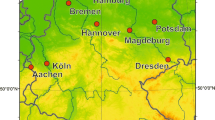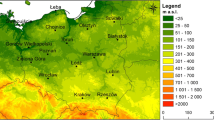Abstract
In the second fortnight of December 2013, the longest heat wave registered until then occurred in Buenos Aires city and over a large region of Argentina, with large socio-economic impacts. Excess heat indexes were used to characterize this heat wave, which occurred within the warm season with largest number of heat wave days. This extreme event resulted in the longest consecutive period of heat wave conditions between 1979 and 2014. This event was the result of the combined activity of short intraseasonal (10–30 days), long intraseasonal (30–90 days) and larger (more than 90 days) time scales. Accounting for the lower frequency, dry soil moisture anomalies were observed in Argentina during autumn, winter and spring of 2013 probably favoring more extreme values in the temperature anomalies. Weekly geopotential heights anomalies computed during the event showed that the combination of the negative phase of the Southern Annular Mode and a wave-4 pattern at midlatitudes favored the development of positive geopotential height anomalies over southern South America which promoted subsidence motions there. Intraseasonal variability played a key role in the persistence of the heat wave. The development of an MJO event over the Indian Ocean (RMM phase 3) 12 days prior to the beginning of the heat wave may have contributed to organize the extratropical wave train which in turn favored the anticyclonic upper-level anomaly development over southern South America. Furthermore, an intense SACZ event during the first 12 days of the heat wave favored clear-sky conditions and diabatic heating as well as subsidence, while during the last days it was the northerly advection of warmer air in the 10–30-day time scale that maintained the intensity of the temperature anomalies.










Similar content being viewed by others
References
Alessandro AP, de Garín AB (2003) A study on predictability of human physiological strain in Buenos Aires City. Meteorol Appl 10(3):263–271
Almeira G, Rusticucci M, Suaya M (2016) Relación entre mortalidad y temperaturas extremas en buenos aires y rosario. Meteorologica 41(2):65–79
Alvarez MS, Vera CS, Kiladis GN (2017) MJO modulating the activity of the leading mode of intraseasonal variability in south America. Atmosphere 8(12):232
Barros VR, Boninsegna JA, Camilloni IA, Chidiak M, Magrín GO, Rusticucci M (2015) Climate change in argentina: trends, projections, impacts and adaptation. Wiley Interdiscip Rev Clim Change 6(2):151–169
Barrucand M, Vargas W, Bettolli ML (2014) Warm and cold dry months and associated circulation in the humid and semi-humid argentine region. Meteorol Atmos Phys 123(3):143–154
Bastos A, Gouveia CM, Trigo RM, Running SW (2014) Analysing the spatio-temporal impacts of the 2003 and 2010 extreme heatwaves on plant productivity in europe. Biogeosciences 11(13):3421–3435
Berrisford P, Dee D, Poli P, Brugge R, Fielding K, Fuentes M, Kållberg P, Kobayashi S, Uppala S, Simmons A (2011) The era-interim archive version 2.0. Shinfield Park, Reading
Bidegain M (2009) Severe drought in central Argentina and Uruguay. In: Peterson TC, Baringer MO (eds) State of the climate in 2008, chapter 7, vol 90. American Meteorological Society, Boston, p S138
Campetella C, Rusticucci M (1998) Synoptic analysis of an extreme heat wave over argentina in March 1980. Meteorol Appl 5(3):217–226
Carril AF, Cavalcanti I, Menéndez C, Sörensson A, López-Franca N, Rivera J, Robledo F, Zaninelli P, Ambrizzi T, Penalba O, da Rocha R, Sánchez E, Bettolli M, Pessacg N, Renom M, Ruscica R, Solman S, Tencer B, Grimm A, Rusticucci M, Cherchi A, Tedeschi R, Zamboni L (2016) Extreme events in the la plata basin: a retrospective analysis of what we have learned during claris-lpb project. Clim Res 68:95–116
Cerne SB, Vera CS (2011) Influence of the intraseasonal variability on heat waves in subtropical South America. Clim Dyn 36(11):2265–2277
Cerne SB, Vera CS, Liebmann B (2007) The nature of a heat wave in eastern Argentina occurring during salljex. Mon Weather Rev 135(3):1165–1174
Dereczynski C, Luiz Silva W, Marengo J (2013) Detection and projections of climate change in Rio de Janeiro, Brazil. Am J Clim Change 2(1):25–33
Duchon CE (1979) Lanczos filtering in one and two dimensions. J Appl Meteorol 18(8):1016–1022
Ek MB, Mitchell KE, Lin Y, Rogers E, Grunmann P, Koren V, Gayno G, Tarpley JD (2003) Implementation of Noah land surface model advances in the national centers for environmental prediction operational mesoscale eta model. J Geophys Res Atmos 108(D22):8851
Fischer EM, Seneviratne SI, Lüthi D, Schär C (2007a) Contribution of land-atmosphere coupling to recent European summer heat waves. Geophys Res Lett 34(6):L06707
Fischer EM, Seneviratne SI, Vidale PL, Lüthi D, Schär C (2007b) Soil moisture–atmosphere interactions during the 2003 European summer heat wave. J Clim 20(20):5081–5099
García-Herrera R, Díaz J, Trigo RM, Luterbacher J, Fischer EM (2010) A review of the European summer heat wave of 2003. Crit Rev Environ Sci Technol 40(4):267–306
Geirinhas JL, Trigo RM, Libonati R, Castro LC, Sousa PM, Coelho CA, Peres LF, de Avelar FM, Magalhāes M (2019) Characterizing the atmospheric conditions during the 2010 heatwave in Rio de Janeiro marked by excessive mortality rates. Sci Total Environ 650:796–808
Gonzalez PLM, Vera CS (2014) Summer precipitation variability over South America on long and short intraseasonal timescales. Clim Dyn 43(7):1993–2007
Hannart A, Vera C, Cerne B, Otto FEL (2015) Causal influence of anthropogenic forcings on the argentinian heat wave of December 2013. Bull Am Meteorol Soc 96(12):S41–S45
Hoegh-Guldberg O, Jacob D, Taylor M, Bindi M, Brown S, Camilloni I, Diedhiou A, Djalante R, Ebi KL, Engelbrecht F, Guiot J, Hijioka Y, Mehrotra S, Payne A, Seneviratne SI, Thomas A, Warren R, Zhou G (2018) Impacts of 1.5 c global warming on natural and human systems. In: Masson-Delmotte V, Zhai P, Portner HO, Roberts D, Skea J, Shukla PR, Pirani A, Moufouma-Okia W, Péan C, Pidcock R, Connors S, Matthews JBR, Chen Y, Zhou X, Gomis MI, Lonnoy E, Maycock T, Tignor MTW (eds) Global Warming of 1.5 C. An IPCC special report on the impacts of global warming of 1.5 C above pre-industrial levels and related global greenhouse gas emission pathways, in the context of strengthening the global response to the threat of climate change, sustainable development, and efforts to eradicate poverty, chapter 3, pp 175–311 (in press)
Leva P, García M, Veles M, Valtorta S (2005) Ganado lechero en la cuenca central de Santa Fe-Córdoba: efecto del estrés estival e impacto esperado del cambio global. FAVE 14(1):39–48. https://doi.org/10.14409/fave.v14i1.3084
Madden RA, Julian PR (1994) Observations of the 40–50-day tropical oscillation: a review. Mon Weather Rev 122(5):814–837
Mueller B, Seneviratne SI (2012) Hot days induced by precipitation deficits at the global scale. Proc Natl Acad Sci 109(31):12398–12403
Müller OV, Berbery EH, Alcaraz-Segura D, Ek MB (2014) Regional model simulations of the 2008 drought in southern south america using a consistent set of land surface properties. J Clim 27(17):6754–6778
Nogues-Paegle J, Mo KC (1997) Alternating wet and dry conditions over South America during summer. Monthly Weather Review 125(2):279–291
Osman M, Alvarez MS (2018) Subseasonal prediction of the heat wave of december 2013 in southern South America by the poama and bcc-cps models. Clim Dyn 50(1):67–81
Perkins SE, Alexander LV (2013) On the measurement of heat waves. J Clim 26(13):4500–4517
Perkins SE, Argüeso D, White CJ (2015) Relationships between climate variability, soil moisture, and australian heatwaves. J Geophys Res Atmos 120(16):8144–8164 2015JD023592
Rodell M, Houser PR, Jambor U, Gottschalck J, Mitchell K, Meng C-J, Arsenault K, Cosgrove B, Radakovich J, Bosilovich M, Entin JK, Walker JP, Lohmann D, Toll D (2004) The global land data assimilation system. Bull Am Meteorol Soc 85(3):381–394
Ruscica RC, Sörensson AA, Menéndez CG (2015) Pathways between soil moisture and precipitation in southeastern South America. Atmos Sci Lett 16(3):267–272
SMN (2014) Informe especial debido a la ocurrencia de una ola decalor excepcional en Argentina durante Diciembre de 2013. Technical report, Servicio Meteorológico Nacional
Spennemann PC, Rivera JA, Saulo AC, Penalba OC (2015) A comparison of gldas soil moisture anomalies against standardized precipitation index and multisatellite estimations over South America. J Hydrometeorol 16(1):158–171
Vera CS, Alvarez MS, Gonzalez PLM, Liebmann B, Kiladis GN (2018) Seasonal cycle of precipitation variability in south America on intraseasonal timescales. Clim Dyn 51(5):1991–2001. https://doi.org/10.1007/s00382-017-3994-1
Vitart F, Ardilouze C, Bonet A, Brookshaw A, Chen M, Codorean C, Déqué M, Ferranti L, Fucile E, Fuentes M, Hendon H, Hodgson J, Kang H-S, Kumar A, Lin H, Liu G, Liu X, Malguzzi P, Mallas I, Manoussakis M, Mastrangelo D, MacLachlan C, McLean P, Minami A, Mladek R, Nakazawa T, Najm S, Nie Y, Rixen M, Robertson AW, Ruti P, Sun C, Takaya Y, Tolstykh M, Venuti F, Waliser D, Woolnough S, Wu T, Won D-J, Xiao H, Zaripov R, Zhang L (2017) The subseasonal to seasonal (s2s) prediction project database. Bull Am Meteorol Soc 98(1):163–173
Wheeler MC, Hendon HH (2004) An all-season real-time multivariate MJO index: development of an index for monitoring and prediction. Mon Weather Rev 132(8):1917–1932
Zhao L, Oppenheimer M, Zhu Q, Baldwin JW, Ebi KL, Bou-Zeid E, Guan K, Liu X (2018) Interactions between urban heat islands and heat waves. Environ Res Lett 13(3):034003
Acknowledgements
The research was supported by PIDDEF 2014/2017 Nro 15 and the CLIMAX Project funded by Belmont Forum. MSA and MO were supported by a PostDoc grant from CONICET, Argentina.
Author information
Authors and Affiliations
Corresponding author
Additional information
Publisher's Note
Springer Nature remains neutral with regard to jurisdictional claims in published maps and institutional affiliations.
Rights and permissions
About this article
Cite this article
Alvarez, M.S., Cerne, B., Osman, M. et al. Intraseasonal and low frequency processes contributing to the December 2013 heat wave in Southern South America. Clim Dyn 53, 4977–4988 (2019). https://doi.org/10.1007/s00382-019-04838-6
Received:
Accepted:
Published:
Issue Date:
DOI: https://doi.org/10.1007/s00382-019-04838-6




